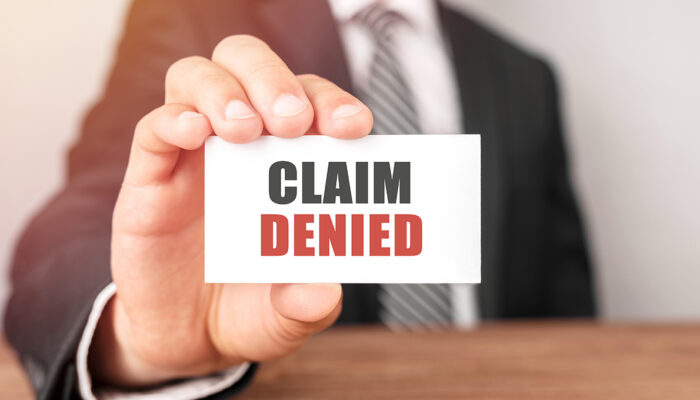Insurance Company Bad Faith refers to tactics that insurance companies use to avoid their contractual obligations to their insureds. Why does an insurance company deny, delay, and devalue claims?
Because insurance companies are in the business of making money. The more money they pay out and the faster they pay it, the less they have to provide to their shareholders and CEO.
The National Association of Insurance Commissioners (NAIC) reports on the most common complaints customers have with their insurance providers. Unsurprisingly, there are a lot of people who feel their insurance company isn’t treating them fairly – mostly because of the way it is handling their claim. People make complaints to the NAIC when:
- an insurance company is not paying their medical bills
- they receive an erroneous notice of cancellation for non-payment or the insurance carrier mysteriously “canceled” their policy on the date before they had an accident
- an insurance company is not accepting fault
- an insurance company is not paying a claim, not paying enough, or not paying the full amount expected
- an insurance company is not returning calls, not answering the phone, or not responding to a claim
- an insurance company denies a claim (refuses to pay out), or the insured feels like they have been treated unfairly, defrauded by the insurance company, or defrauded by an insurance agent who told them that they had coverage their policy doesn’t actually include
- an insurance company is taking too long to pay a claim
In all of these circumstances, you have some options. Here are five steps to handling a shady insurance provider. For the purpose of this article, we are going to primarily discuss Arizona Car Accident Claims, but much of the advice will apply to other types of claims in other locations.
1.KNOW YOUR COVERAGE, YOUR RIGHTS, AND THEIR RESPONSIBILITIES
Check your coverages and know what you have so you are prepared if and when you are involved in an accident. Does your insurance policy cover liability only (where you are at fault) or does it cover uninsured and underinsured drivers who may be responsible for the accident? Do you have medical payments coverage? Are you covered for a rental car if your vehicle is disabled? What happens if you let a relative, such as your cousin, drive your car?
The records you need to keep are a) a copy of your insurance policy, b) a copy of your application for insurance, and c) a copy of your current ID card, which should be in your wallet or glove compartment at all times.
If the contents of your insurance policy don’t line up with what the agent says you are allowed, you need to address it immediately before it becomes an issue; however, if you can later prove that the agent was negligent in providing you with coverage, or that he/she committed insurance agent malpractice or professional negligence, you may have a claim against them for the losses you suffered as a result of their actions. Ironically, insurance agents are covered under their own Errors and Omissions insurance for this purpose.
Your policy also contains a number of other important details, including instructions on how and when to submit a claim and the the provider’s process for handling your claim and property damage. The policy will also tell you whether a dispute with the insurance company must be resolved through arbitration rather than a lawsuit.
While you don’t have the right to decide what you should be paid, you have the absolute right to be treated “fairly” in the claims process. “Unfair Claims Settlement Practices” are generally defined in Arizona Revised Statutes, Title 20 §20-461 and include:
- Lying about facts or policy provisions
- Not acting reasonably or quickly in response to communications
- Not investigating promptly
- Refusing to pay claims without conducting a reasonable investigation
- Not making a good effort to quickly and fairly settle claims when liability is clear
- Forcing insureds to file suit to get what they are owed
- Trying to settle a claim for less than a reasonable person would think they are entitled to
- Altering documents to try to force settlement
- Delaying settlement under one portion of the policy (like property damage coverage) to force settlement under another portion of the policy (like bodily injury)
- Not promptly providing a reasonable explanation for denial of a claim or a bad offer
2. MAKE A RECORD OF ALL COMMUNICATIONS
The most important thing you can do from even before the beginning of your claim is to keep very good records. Use this handy sheet to track your communications with the insurance company, and keep it in a safe place with all the documents that support your loss. It is a good idea to keep all of the information related to your case in the same folder so it is easy to find, such as the folder provided by Fite Law Group specifically for this purpose.
Tracking the dates and times you communicated with the insurance company, who you spoke to, and what you discussed is essential to proving whether the insurance company has acted unfairly, and helpful to your lawyer should you choose to seek legal action.
Other contents of your folder should include photos of your property damage, photos of your injuries, copies of every letter the insurance company sends you, and any information you have that would show increased value of your vehicle, such as receipts for custom rims, paint job, brand new transmission, etc.. Medical records and bills should also go in the folder, as well as any communications you have with your employer about time off or lost wages related to the accident.
If you know that your case is going to be complex, or if you just are not good at keeping records, consider hiring a lawyer immediately after the accident so they can handle these tasks for you. You will still need to be involved in the process, but since communications with the insurance company are handled by the law firm, it will be less to worry about.
3. BE PERSISTENT, BUT CALM
The point of insurance companies denying, delaying, and devaluing claims is to wear you down. They have all the time in the world to spend doing nothing else; however, you have a life that, presumably, you want to get back to living. Trying to fight the insurance company is a huge undertaking on top of caring for yourself, your family, your job, your bills, and everything else you have going on. The insurance company knows this and are well aware that when they deny a claim, a certain percentage of people will just give up. They are also aware of the average number of people that will accept a delay or small payout without a fight. They literally bank on the fact that claimants will be so worn down by the process, that they will accept any payment just so they can put the matter to rest and move on.
Tactics the insurance company may use include having you jump through unnecessary hoops, such as asking for a recorded statement or a medical exam. Sometimes, they may hire a “medical expert” to review your medical records and bills to determine whether your injuries are actually related to the accident. They may even claim that fees for your medical treatment are higher than necessary for the care you received, which puts you in the uncomfortable position of disputing your medical bills with your healthcare providers.
Be the squeaky wheel. Put up a fight! (or, a “Fite” if you hire Fite Law Group). Keep calling and writing to the insurance company until your questions are answered to your satisfaction. Do not let an agent bully you or down play your situation. Ask to speak to a supervisor and keep moving up the chain of command. The bottom line is that you are the customer. You pay for your insurance specifically to cover the claims related to an accident. Keep fighting until you get what you deserve.
Be firm when dealing with the insurance company, but always remain calm and respectful. Insurance adjusters are people too. They have good and bad days just like the rest of us. Treating them with respect is your best chance at receiving the same courtesy. Insurance adjusters also have a range within which they can negotiate. Treating them poorly won’t get you to the upper end of their range.
4. MAKE A FORMAL COMPLAINT
You have options when you are having issues with your insurance adjuster or provider. Escalate your case to a supervisor or higher when warranted, such as when the adjuster goes off grid and stops returning your calls. The insurance company itself is regulated by the Arizona Department of Insurance. You can file a consumer complaint if you feel your insurance carrier is acting inappropriately or proving difficult to work with.
5. UNDERSTAND THE VALUE OF HIRING A LAWYER
Consider hiring a lawyer if the potential value of your claim is very high because the insurance company will have a very high interest in paying you a lot less than the full value you actually deserve. Although the rules of fairness require that the insurance providers consider your interests to be as important as their own, in reality, they are in business to make money. Payouts cut into their profits, which in turn, hits the pockets of shareholders and executives. In contrast, Personal injury lawyers that represent car accident clients have aligned interests. Typically, their payments are contingent on what you are paid by the insurance company.
If the insurance company wants to take an examination under oath, also known as a statement under oath or a deposition, it is a very good idea to have a lawyer involved in the process. Personal injury attorneys handle hundreds to thousands of cases like yours each year. They know the process and the pitfalls, and can advise on how best to handle your specific situation.
For more information on why you might want to hire a lawyer, read our recent post on 20 Ways a Car Accident Lawyer Can Maximize Your Insurance Claim.
Hiring a lawyer does not necessarily mean you will be filing a lawsuit, which is often expensive and time consuming. In most instances, a lawsuit is only filed as a last resort when all other avenues have been exhausted. If you are worried that involving a lawyer will make the insurance company agitated or somehow hurt your case, seek advice from friends and family members. It is highly likely that you know other people who have been involved in a car accident and used legal counsel to help fight their case. Fite Law Group prides itself on receiving most of its new clients through referrals from friends and family members.
If you are have been involved in an accident, call us at (602) 368-1869 for a free evaluation of your case. Hate talking on the phone? Text us at 480.688.7544 to set up a virtual appointment.










